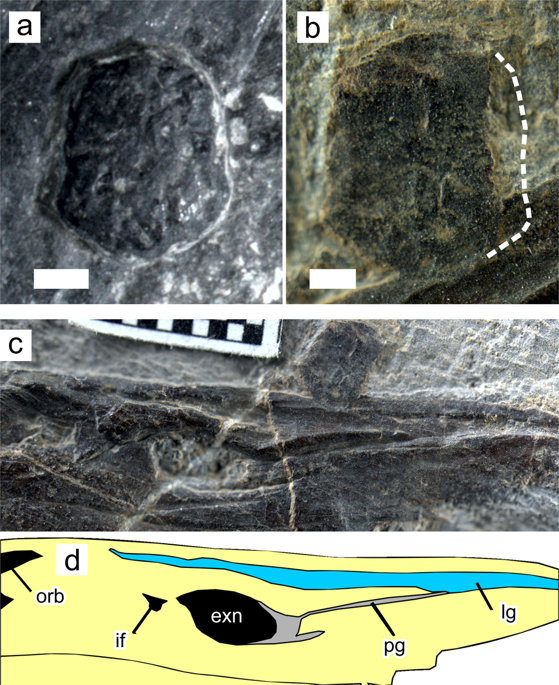@ WFS,World Fossil Society,Riffin T Sajeev,Russel T Sajeev
No animal alive today looks quite like a duckbilled platypus, but about 250 million years ago something very similar swam the shallow seas in what is now China, finding prey by touch with a cartilaginous bill. The newly discovered marine reptile Eretmorhipis carrolldongi from the lower Triassic period is described in the journal Scientific Reports Jan. 24.
Apart from its platypus-like bill, Eretmorhipis was about 70 centimeters long with a long rigid body, small head and tiny eyes, and four flippers for swimming and steering. Bony plates ran down the animal’s back.

First nearly complete specimen of the rare hupehsuchian Eretmorhipis carrolldongi (YAGM V 1401), revealing an unusually small skull. (a) photograph. (b) outlines of the bones and impressions. (c) skeletal reconstruction, with flippers from the holotype. The ruler is 5 cm long.
Eretmorhipis was previously known only from partial fossils without a head, said Professor Ryosuke Motani, a paleontologist at the University of California, Davis Department of Earth and Planetary Sciences and coauthor on the paper.
“This is a very strange animal,” Motani said. “When I started thinking about the biology I was really puzzled.”
The two new fossils show the animal’s skull had bones that would have supported a bill of cartilage. Like the modern platypus, there is a large hole in the bones in the middle of the bill. In the platypus, the bill is filled with receptors that allow it to hunt by touch in muddy streams.
In the early Triassic, the area was covered by a shallow sea, about a meter deep, over a carbonate platform extending for hundreds of miles. Eretmorhipis fossils were found at what were deeper holes, or lagoons, in the platform. There are no fossils to show what Eretmorhipis ate, but it likely fed on shrimp, worms and other small invertebrates, Motani said.

The skull and mandible of Eretmorhipis carrolldongi in two new specimens. (a) and (b) YAGM V 1401, in dorsal view. (c) and (d) WGSC V 1601, in ventral view. Scale bars are 20 mm long. Symbols: at, atlas; atns, atlantal neural spine; ax, axis; axnp, axial neural spine; bh, basihyal lingual process; ch, ceratohyal; f, frontal; j, jugal; l, lacrimal; lg, labial groove for labial cartilage; m, maxilla; mand, mandibular rami; n, nasal; os, bone resembling os paradoxum; p, parietal; palatal, unidentified palatal bones; pl, palatine; pm, premaxilla; pob, postorbital; prf, prefrontal; ps-bs, parasphenoid-basisphenoid complex; pt, pterygoid; ptf, postfrontal; q, quadrate; sq, squamosal; st, supratemporal; v, vomer.
Its long, bony body means that Eretmorhipis was probably a poor swimmer, Motani said.
“It wouldn’t survive in the modern world, but it didn’t have any rivals at the time,” he said.
Related to the dolphin-like ichthyosaurs, Eretmorhipis evolved in a world devastated by the mass extinction event at the end of the Permian era. The fossil provides more evidence of rapid evolution occurring during the early Triassic, Motani said.

Preorbito-external-narial region of Eretmorhipis carrolldongi and a bone resembling os paradoxum. (a) ‘Os paradoxum’ of WGSC V 1601, in ventral view with unfinished surface. (b) Same of YAGM V 1401, in dorsal view revealing a median ridge; (c)-(d) Preorbito-external-narial region of YAGM V 1401. Scales for (a) and (b) are 1 mm, and each square in (c) has a side length of 1 mm. See Fig. 4 for symbols.
Co-authors on the study are Long Cheng and Chun-bo Yan, Wuhan Centre of China Geological Survey, Wuhan; Da-yong Jiang, Peking University; Andrea Tintori, Università degli Studi di Milano, Italy; and Olivier Rieppel, The Field Museum, Chicago. The work was supported by grants from the China Geological Survey, the National Natural Science Foundation of China and the Ministry of Science and Technology.
Journal Reference:
- Long Cheng, Ryosuke Motani, Da-yong Jiang, Chun-bo Yan, Andrea Tintori, Olivier Rieppel. Early Triassic marine reptile representing the oldest record of unusually small eyes in reptiles indicating non-visual prey detection. Scientific Reports, 2019; 9 (1) DOI: 10.1038/s41598-018-37754-6
@ WFS,World Fossil Society,Riffin T Sajeev,Russel T Sajeev



 January 26th, 2019
January 26th, 2019  Riffin
Riffin  Posted in
Posted in  Tags:
Tags: 